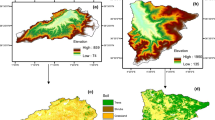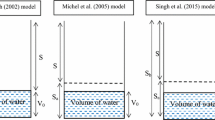Abstract
The aims of this paper are to (I) clarify some issues related to the popular rainfall–runoff SCS-CN (Soil Conservation Service Curve Number) methodology and (II) propose enhanced SCS-CN inspired models for simulation of long-duration (viz., bimonthly, monthly, seasonally, and annually) rainfall-generated runoff and compares its performance with the existing SCS-CN models and Mishra and Singh 1999 model. Issues of SCS-CN are: (a) both C (runoff coefficient) and CN (curve number) with P (rainfall) in contrast to that exhibited by field data, (b) F (infiltration) with Q (direct runoff), (c) Ia (initial abstraction) with S (potential maximum retention), and (d) CN that is also taken as an index of runoff potential. The performance of the proposed SCS-CN inspired models (M3-M8), the existing SCS-CN models (M1 and M2), Mishra and Singh 1999 model (M9), and a special case of M9 that hypothesizes that initial abstraction coefficient (λ) = 0 (M10) are tested using rainfall–runoff data of four different agro-climatic river basins in Ethiopia. The performance of the models is evaluated using three statistical criteria involving NSE, RSR, and PBIAS. The resulting high NSE values and lowest RSR and PBIAS for the proposed models reveal that proposed models performed better to different (majority) duration datasets than the existing models. Similarly, the proposed models, when employed to the observed datasets of different timescales, performed satisfactorily in both calibration and validation for all watersheds, underlining the efficacy of the proposed models in field applications.















Similar content being viewed by others
Data availability
Data used during the study are available from the corresponding author by request and with permission of the National Meteorological Agency of Ethiopia and the Ministry of Water, Irrigation and Electricity of Ethiopia.
References
Ajmal M, Waseem M, Wi S, Kim TW (2015) Evolution of a parsimonious rainfall-runoff model using soil moisture proxies. J Hydrol 530:623–633
Aragaw HM, Mishra SK (2021) Runoff curve number-potential evapotranspiration-duration relationship for selected watersheds in Ethiopia. Model Earth Syst Environ 6:1–12
Aragaw HM, Goel MK, Mishra SK (2021) Hydrological responses to human-induced land use/land cover changes in the Gidabo River basin Ethiopia. Hydrol Sci J 66(4):640–655
Arnold JG, Srinivasan R, Muttiah RS, Williams JR (1998) Large area hydrologic modeling and assessment part I: model development. J Am Water Resour Assoc 34(1):73–89
Beretta L, Santaniello A (2016) Nearest neighbor imputation algorithms: a critical evaluation. BMC Med Inf Decision Mak 16(Suppl 3):871
Bhunya PK, Jain SK, Singh PK, Mishra SK (2010) A simple conceptual model of sediment yield. Water Resour Manage 24(8):1697–1716
Chakraborty S, Pandey RP, Mishra SK, Chaube UC (2015) Relation between runoff curve number and irrigation water requirement. Agric Res 4(4):378–387
Chin DA (2018) On relationship between curve numbers and phi indices. Water Sci Eng 11(3):187–195
Devia GK, Ganasri BP, Dwarakish GS (2015) A review on hydrological models. Aquatic Procedia 4:1001–1007
Durbude DG, Jain MK, Mishra SK (2011) Long-term hydrologic simulation using SCS-CN-based improved soil moisture accounting procedure. Hydrol Process 25(4):561–579
Garen DC, Moore DS (2005) Curve number hydrology in water quality modeling: Uses, abuses, and future directions. J Am Water Resour Assoc 41(2):377–388
Geetha K, Mishra SK, Eldho TI, Rastogi AK, Pandey RP (2007) Modifications to SCS-CN method for long-term hydrologic simulation. J Irrig Drain Eng 133(4):395–406
Geetha K, Mishra SK, Eldho TI, Rastogi AK, Pandey RP (2008) SCS-CN-based continuous simulation model for hydrologic forecasting. Water Resour Manage 22(2):165–190
Gupta HV, Kling H, Yilmaz KK, Martinez GF (2009) Decomposition of the mean squared error and NSE performance criteria: Implications for improving hydrological modelling. J Hydrol 377(1–2):80–91
Haith DA, Shoenaker LL (1987) Generalized watershed loading functions for stream flow nutrients. JAWRA J Am Water Resour Assoc 23(3):471–478
Hapuarachchi HAP, Wang QJ, Pagano TC (2011) A review of advances in flash flood forecasting. Hydrol Process 25(18):2771–2784
Hawkins RH (1993) Asymptotic determination of runoff curve numbers from data. J Irrig Drain Eng 1(August):334–345
Hawkins RH, Jiang R, Woodward DE, Hjelmfelt AT, Van Mullem JA, Quan QD (2003) Runoff curve number method: examination of the initial abstraction ratio. World Water Environ Resour Congress 35:691–700
Hawkins RH, Ward TJ, Woodward DE, Van Mullem JA (2009) Curve number hydrology: state of the practice. American Society of Civil Engineers, Virginia
Hooshyar M, Wang D (2016) An analytical solution of Richards’ equation providing the physical basis of SCS curve number method and its proportionality relationship. Water Resour Res 52:6611–6620
Jain MK, Mishra SK, Babu PS, Venugopal K, Singh VP (2006a) Enhanced runoff curve number model incorporating storm duration and a nonlinear IA-S relation. J Hydrol Eng 11(6):631–635
Jain MK, Mishra SK, Babu PS, Venugopal K (2006b) On the Ia - S relation of the SCS-CN method. Nord Hydrol 37(3):261–275
Jain MK, Mishra SK, Singh VP (2006c) Evaluation of AMC-dependent SCS-CN-based models using watershed characteristics. Water Resour Manage 20(4):531–552
Jain MK, Durbude DG, Mishra SK (2012) Improved CN-based long-term hydrologic simulation model. J Hydrol Eng 17(11):1204–1220
Kannan N, Williams SJR, Arnold JG (2007) Development of a continuous soil moisture accounting procedure for curve number methodology and its behaviour with different evapotranspiration methods. Hydrol Processes 2274:2267–2274
Knisel, W. G., 1980. CREAMS: a field scale model for Chemicals, runoff, and erosion from agricultural management systems [USA]. Dept. of Agriculture, Science and Education Administration.
Krause P, Boyle DP, Bäse F (2005) Comparison of different efficiency criteria for hydrological model assessment. Adv Geosci 5:89–97
Lim KJ, Engel BA, Tang Z, Choi J (2006) Automated web GIS based hydrograph analysis tool, What. J Am Water Resour Assoc 1397(6):1407–1416
Michel C, Andréassian V, Perrin C (2005) Soil conservation service curve number method: How to mend a wrong soil moisture accounting procedure? Water Resour Res 41(2):1–6
Mishra SK, Singh VP (1999) Another look at SCS-CN Method. J Hydrol Eng 4(July):257–264
Mishra SK, Singh VP (2003) Soil conservation service curve number (SCS-CN) methodology. Kluwer, Dordrecht, p 42
Mishra SK, Singh VP (2004) Long-term hydrological simulation based on the soil conservation service curve number. Hydrol Process 18(7):1291–1313
Mishra SK, Singh VP (2006) A relook at NEH-4 curve number data and antecedent moisture condition criteria. Hydrol Process 20(13):2755–2768
Mishra SK, Jain MK, Singh VP (2004) Evaluation of the SCS-CN-based model incorporating antecedent moisture. Water Resour Manage 18(6):567–589
Mishra SK, Jain MK, Bhunya PK, Singh VP (2005) Field applicability of the SCS-CN-based Mishra-Singh general model and its variants. Water Resour Manage 19(1):37–62
Mishra SK, Sahu RK, Eldho TI, Jain MK (2006a) An improved Ia-S relation incorporating antecedent moisture in SCS-CN methodology. Water Resour Manage 20(5):643–660
Mishra SK, Tyagi JV, Singh VP, Singh R (2006b) SCS-CN-based modeling of sediment yield. J Hydrol 324(1–4):301–322
Mishra SK, Pandey RP, Jain MK, Singh VP (2008) A rain duration and modified AMC-dependent SCS-CN procedure for long duration rainfall-runoff events. Water Resour Manage 22(7):861–876
Mishra SK, Rawat SS, Pandey RP, Chakraborty S, Jain MK, Chaube UC (2014) Relationship between runoff curve number and PET. J Hydrol Eng 19(5):355–365
Mishra SK, Kumre SK, Pandey A (2019) SCS-CN method revisited in perspective of strange data. Int J Hydrol 3(4):488–498
Moglen GE (2000) Effect of orientation of spatially distributed curve number in runoff calculations. Am Water Resour Assoc 36(6):1391–1400
Moriasi DN, Arnold JG, Van Liew MW, Bingner RL, Harmel RD, Veith TL (2007) Model evaluation guidelines for systematic quantification of accuracy in watershed simulations. Am Soc Agric Biol Eng 50(3):885–900
Nash JE, Sutcliffe JV (1970) River flow forecasting through conceptual models part i–a discussion of principles*. J Hydrol 10(2):282–290
Neitsch SL, Arnold JG, Kiniry JR, Williams JR, and King KW (2002) Soil and water assessment tool (SWAT): theoretical documentation, version 2000. Texas Water Resources Institute, College Station, Texas TWRI Report TR-191.
Pérez-Sánchez J, Senent-Aparicio J, Segura-Méndez F, Pulido-Velazquez D, Srinivasan R (2019) Evaluating hydrological models for deriving water resources in peninsular Spain. Sustainability 11(10):1–36
Ponce VM, Hawkins RH (1996) Runoff curve number: Has it reached maturity? J Hydrol Eng 2(3):145–148
Rallison RE (1980) Origin and Evolution of the SCS runoff equation. In: A.S.C.E. Irrig. and Drain. Symp. on Watershed Management. New York: A.S.C.E., 912–924.
Sahu RK, Mishra SK, Eldho TI, Jain MK (2007) An advanced soil moisture accounting procedure for SCS curve number method. Hydrol Process 2274:2267–2274
Sahu RK, Mishra SK, Eldho TI (2010) An improved AMC-coupled runoff curve number model. Hydrol Process 24(20):2834–2839
Satheeshkumar S, Venkateswaran S, Kannan R (2017) Rainfall–runoff estimation using SCS–CN and GIS approach in the Pappireddipatti watershed of the Vaniyar sub basin, South India. Modeling Earth Systems and Environment 3(1):1–8
SCS, 1956. National Engineering Handbook, Section 4 Hydrology. Washington, DC.
Seibert J (2001) On the need for benchmarks in hydrological modelling. Hydrol Process 15(6):1063–1064
Sharpley AN and Williams J (1990) EPIC-Erosion/Productivity Impact Calculator. I: Model documentation. II: User manual. Technical Bulletin-United States Department of Agriculture.
Shi W, Huang M, Gongadze K, Wu L (2017) A modified SCS-CN method incorporating storm duration and antecedent soil moisture estimation for runoff prediction. Water Resour Manage 31(5):1713–1727
Singh VP, Frevert DK, Treviño MA, Meyer SP, Rieker JD (2006) The hydrologic modeling inventory. a cooperative research effort. Watershed Manag Op Manag 132(2):98–103
Subramanya K (2013) Engineering Hydrology. Fourth Ed. New Delhi: (India) Pvt. Ltd.
Tedela NH, McCutcheon SC, Campbell JL, Swank WT, Adams MB, Rasmussen C (2012a) Curve numbers for nine mountainous eastern united states watersheds: seasonal variation and forest cutting. J Hydrol Eng 17(11):1199–1203
Tedela NH, McCutcheon SC, Rasmussen TC, Hawkins RH, Swank WT, Campbell JL, Adams MB, Jackson R, Tollner EW (2012b) Runoff curve numbers for 10 small forested watersheds in the mountains of the eastern united states. J Hydrol Eng 17(11):1188–1198
Thornthwaite CW (1948) An approach toward a rational classification of climate C. Geogr Rev 38(1):55–94
Tyagi JV, Mishra SK, Singh R, Singh VP (2008) SCS-CN based time-distributed sediment yield model. J Hydrol 352(3–4):388–403
Verma S, Mishra SK, Singh A, Singh PK, Verma RK (2017) An enhanced SMA based SCS-CN inspired model for watershed runoff prediction. Environ Earth Sci 76(21):1–20
Verma RK, Verma S, Mishra SK, Pandey A (2021) SCS-CN-Based improved models for direct surface runoff estimation from large rainfall events. Water Resour Manage 35:2149–2175
White D (1988) G K I D - B a s e d application of runoff curve numbers. Water Resour Plann Manag 114(6):601–612
Young RA, Onstad CA, Bosch DD, Anderson WP (1989) AGNPS: a nonpoint-source pollution model for evaluating agricultural watersheds. Soil Water Conserv 44(2):168–173
Yuan Y, Mitchell JK, Hirschi MC, Cooke RAC (2001) Modified SCS curve number method for predicting subsurface drainage flow. Trans Am Soc Agric Eng 44(6):1673–1682
Zhou S-M, Warrington DN, Lei T-W, Lei Q-X, Zhang M-L (2015) Modified CN method for small watershed infiltration simulation. J Hydrol Eng 20(9):04014095
Acknowledgements
The authors express their thanks to the National Meteorological Agency of Ethiopia (NMAoE) and the Ministry of Water, Irrigation and Electricity of Ethiopia (MoWIE) for providing the climate and hydrological data respectively.
Funding
Not applicable.
Author information
Authors and Affiliations
Corresponding author
Ethics declarations
Conflict of interest
The authors declare no conflict of interests.
Additional information
Communicated by Dr. Michael Nones (CO-EDITOR-IN-CHIEF).
Rights and permissions
About this article
Cite this article
Aragaw, H.M., Mishra, S.K. Clarification of issues and long-duration hydrologic simulation SCS-CN-based proxy modelling. Acta Geophys. 70, 729–756 (2022). https://doi.org/10.1007/s11600-022-00730-w
Received:
Accepted:
Published:
Issue Date:
DOI: https://doi.org/10.1007/s11600-022-00730-w




